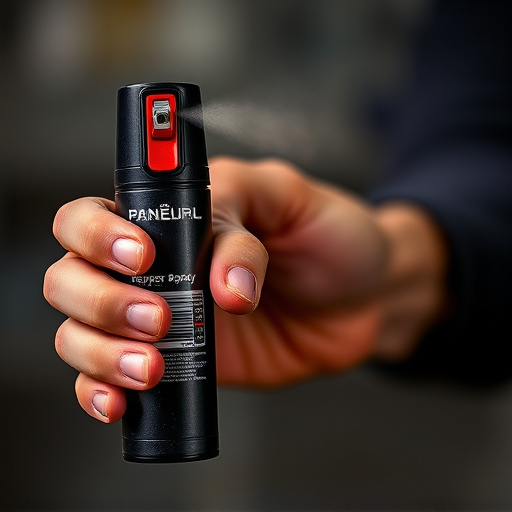Defensive pepper spray, a regulated non-lethal tool for crowd control, has a critical distance range of 20-30 feet (6-9 meters) governed by regional laws. Effective deployment requires training in aiming techniques, de-escalation strategies, and consideration of environmental factors. Officers must adhere to guidelines on minimum safe distances to ensure public safety and protect civil rights, making it a last resort tool for managing volatile situations in bustling cities.
Riot control agents, particularly defensive pepper spray, have become integral tools for law enforcement in managing public order. This article explores the legal perspective of these agents, focusing on their regulation and the delicate balance between public safety and individual rights. We delve into the effective distance of defensive pepper spray, as understanding its range is crucial for tactical deployment. Case studies highlight how this knowledge can mitigate risks while ensuring swift and proportionate responses to civil unrest.
- Understanding Riot Control Agents: A Legal Perspective
- Defensive Pepper Spray: The Tool and Its Regulations
- Determining the Effective Distance of Pepper Spray
- Balancing Public Safety and Individual Rights: Case Studies
Understanding Riot Control Agents: A Legal Perspective
Riot control agents, including defensive pepper spray, are powerful tools employed by law enforcement to manage and disperse violent crowds or individuals during civil unrest or high-tension situations. These agents operate by causing temporary physical disability and discomfort, allowing for the safe restoration of order. However, their use is tightly regulated due to potential health risks and civil liberties concerns.
From a legal perspective, understanding the defensive pepper spray distance range is crucial. Law enforcement agencies must adhere to strict protocols regarding the deployment of such agents, including the minimum safe distance required from bystanders and non-target individuals. This is to ensure that the use of force is proportional and does not cause unnecessary harm or infringe upon civil rights. The specific regulations vary across jurisdictions but generally dictate the defensive pepper spray distance range as a safety measure to protect both officers and citizens alike.
Defensive Pepper Spray: The Tool and Its Regulations
Defensive pepper spray is a powerful tool employed by law enforcement agencies and security personnel for riot control and crowd management. This non-lethal agent is designed to disable individuals temporarily, providing crucial time for officers to gain control of a situation or arrest suspects. The primary active ingredient in most defensive pepper sprays is capsaicin, extracted from chili peppers, which causes irritation and burning sensations when it comes into contact with the eyes, skin, and respiratory system.
Regulations surrounding defensive pepper spray are stringent and vary by jurisdiction. Key considerations include the permitted distance range for deployment, safety precautions, and specific training requirements for officers. In many places, law enforcement officers must undergo specialized training to ensure they can use the spray effectively and responsibly within recommended defensive pepper spray distance ranges. This includes learning proper application techniques, understanding de-escalation strategies, and knowing when it’s appropriate to deploy the spray to minimize risks of injury or misuse.
Determining the Effective Distance of Pepper Spray
Determining the effective distance a defensive pepper spray can reach is crucial for law enforcement officers to ensure their safety and make informed decisions during volatile situations. The range at which pepper spray is effective varies significantly based on several factors, including wind speed and direction, atmospheric conditions, and the specific type of spray used. Typically, the recommended defensive pepper spray distance range is between 20 to 30 feet (6 to 9 meters), but this can be affected by the angle and force at which it’s deployed.
Officers must consider the proximity of suspects and potential bystanders when deciding when and how to use pepper spray. Holding the spray canister at a slight angle and aiming for the face or eyes can maximize its effectiveness within the stated distance range. It’s also important to note that training and experience play a vital role in accurately assessing and managing the defensive pepper spray distance, ensuring it’s used as a last resort when other de-escalation tactics have failed.
Balancing Public Safety and Individual Rights: Case Studies
In the realm of law enforcement, balancing public safety and individual rights is a delicate act, especially when employing riot control agents like defensive pepper spray. These powerful tools can quickly de-escalate dangerous situations, but their use must be carefully regulated to prevent misuse and protect citizens’ rights. The strategic deployment of defensive pepper spray, considering its distance range, plays a pivotal role in these dynamics.
Case studies from bustling metropolis areas highlight the importance of adhering to specific guidelines. For instance, law enforcement agencies have implemented policies that dictate the minimum safe distance for deploying pepper spray, ensuring it’s only used when other de-escalation tactics fail and when officers themselves are at risk. These measures reflect a thoughtful approach, demonstrating an understanding of the impact of such agents on individuals’ well-being, especially in crowded public spaces.
The use of riot control agents, particularly defensive pepper spray, by law enforcement raises complex legal and ethical considerations. While these tools can be essential for maintaining public safety during high-risk situations, it’s crucial to balance their deployment with respect for individual rights. Understanding the effective distance of defensive pepper spray (within a typical range of 2–3 meters) is vital for ensuring its responsible use. As demonstrated in various case studies, striking a delicate equilibrium between public safety and civil liberties is paramount to upholding the rule of law during civil unrest or violent encounters.
